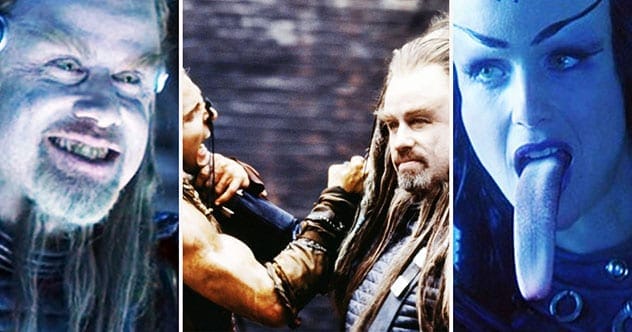Moviemaking is a high-stakes game, where studios often gamble huge sums of money on a single project. While some movies become blockbuster hits, many others fail to recoup their costs, leading to significant financial losses. For instance, 2017’s Justice League, despite grossing $657.9 million, didn’t break even for Warner Bros., needing $750 million to do so.
Although Warner Bros. survived that $60 million loss, numerous studios throughout Hollywood’s history haven’t been so fortunate. Some were forced to sell assets, while others shut down entirely. Let’s explore ten movies that destroyed the studios that made them (amounts adjusted for inflation to 2020).
Cutthroat Island (1994)
Carolco Pictures, once famed for hits like Terminator 2: Judgment Day and Basic Instinct, is now remembered for something far less glorious. In 1994, facing financial difficulties, the studio invested approximately $98 million ($172 million today) in Cutthroat Island.
While this amount is typical for a big tentpole picture today, in the early ’90s, it was a make-or-break proposition. For Carolco Pictures, it was the latter. Riddled with problems, including set rebuilds, scene reshoots, and actor replacements, everything that could go wrong, did.
Cutthroat Island grossed only about $10 million ($17.5 million) globally. This financial disaster devastated Carolco Pictures, leading to the sale of film rights to foreign markets and a Chapter 11 bankruptcy filing just weeks after the film’s release.
The Golden Compass (2007)
New Line Cinema, familiar with high-stakes gambles after the Lord of the Rings trilogy, risked it all again with The Golden Compass, an adaptation of Philip Pullman’s His Dark Materials. The studio invested $180 million ($225.9 million), envisioning it as the first of three films.
This was a significant investment, almost matching the $200 million spent on all three Lord of the Rings films. Unfortunately, The Golden Compass flopped, making only $372 million ($466.9 million), far below the break-even point.
Within a year, New Line restructured, sold its foreign rights, and was ultimately acquired by Warner Bros. Studios. While the company still exists, its films are now the property of Warner Bros.
Heaven’s Gate (1980)
United Artists, a studio known for classics like Raging Bull, Annie Hall, and Apocalypse Now, took a major hit with Michael Cimino’s Heaven’s Gate. Despite a star-studded cast, the film bombed upon its release in 1980.
Though initially panned, it has since gained critical acclaim, but this didn’t help United Artists. The studio spent $44 million ($138.9 million) on the film, which grossed only $3.5 million ($11 million).
Unable to recover its costs, United Artists declared bankruptcy. Metro-Goldwyn-Meyer purchased the studio’s remnants in 1981 for $350 million ($1 billion). After several revivals and mergers, UA was once again revived by MGM as United Artists Releasing.
Raise the Titanic (1980)
Based on the 1976 book, Raise the Titanic was an ambitious and expensive gamble for ITC Entertainment. Released in 1980, the film had a massive budget of $40 million ($126 million).
The film sank at the box office, earning only $7 million ($22 million). These financial losses were crippling, leading to the sale of the film division, Associated Film Distribution, to Universal Pictures.
Lord Grade, the film’s producer, retired from moviemaking after this failure, quipping that “it would have been cheaper to lower the Atlantic.” The remaining assets of ITC focused on television, but the company eventually became defunct in 1998.
Titan A.E. (2000)
In the 1990s, 20th Century Fox launched Fox Animation Studios to enter the animated film market. After a small profit with Anastasia, animator Don Bluth created Titan A.E., co-written by Joss Whedon. The film was given a budget of $30 million ($45 million) for pre-production, which was later boosted with an additional $55 million ($83 million).
Titan A.E. bombed at the box office, earning only $9.4 million ($14 million) against its $85 million budget. Fox Animation Studios suffered a total loss of $100 million ($181 million) from the movie. Ten days after its release, the studio shut down and was eventually replaced by Blue Sky Studios.
Cleopatra (1963)
When 20th Century Fox greenlit Cleopatra, the studio allocated $44 million ($374 million), the largest movie budget ever at the time. Production was plagued with problems, including director and cast changes, and expensive set reconstructions.
A scandal involving Elizabeth Taylor and Richard Burton added to its infamy. While Cleopatra was the highest-grossing movie of 1963, its $57.7 million ($490 million) box office earnings couldn’t cover its production and marketing costs.
20th Century Fox nearly went bankrupt, ceasing all production and selling off 300 acres of its lot. Several executives lost their jobs, and the studio barely survived.
The Right Stuff (1983)
The Ladd Company, founded by Alan Ladd, Jr. (who greenlit Star Wars), aimed for ambitious projects such as The Right Stuff and Twice Upon a Time. Though critically acclaimed for its portrayal of the early American space program, The Right Stuff failed to attract a large audience.
Around the same time, The Ladd Company released Twice Upon a Time, an animated film with George Lucas as executive producer. Like The Right Stuff, it was costly but not profitable. These films sealed the fate of The Ladd Company.
The studio effectively died in 1985 when Ladd took over United Artists. The label was revived in 1995 in partnership with Paramount for Braveheart.
One From the Heart (1982)
In the early 1980s, Francis Ford Coppola co-wrote and directed a musical called One From the Heart. The movie’s budget ballooned from $8 million ($21.5 million) to $26 million ($70 million), an extraordinary sum for a musical in 1982.
One From the Heart grossed a mere $636,796 ($1.7 million) worldwide, after being released in only 41 theaters. Coppola produced the movie through his company, Zoetrope Studios, raising money through pre-sales.
Paramount pulled distribution, and Coppola faced a financial nightmare, personally declaring Chapter 11 bankruptcy over a $71 million ($191.5 million) debt. Coppola endured a decade of financial struggles, and while he saved Zoetrope, it was at a significant cost.
Battlefield Earth (2000)
Battlefield Earth, based on the L. Ron Hubbard book, was John Travolta’s passion project. He invested $5 million ($7.5 million) of his own money into the film. Universally panned, it is infamous as one of the worst movies ever made.
The movie grossed just under $30 million ($45 million) against its $73 million ($110 million) budget, leading to legal issues for Franchise Pictures. The studio was accused of fraudulently inflating the movie’s budget by $31 million ($46.8 million).
A lawsuit by German distributor Intertainment proved Franchise Pictures had stolen funds. The court ordered a $77 million ($116 million) payment, resulting in the bankruptcy of Franchise Pictures. The movie’s failure, compounded by legal troubles, sealed the studio’s fate.
It’s a Wonderful Life (1946)
Today, It’s a Wonderful Life is considered a classic, but it was a massive failure upon its release in 1946. The film cost Liberty Films around $3.2 million ($42.7 million) to produce, a huge sum for a movie with minimal special effects.
With a break-even point of $6.3 million ($84 million), the movie barely surpassed its budget at the box office. This financial failure led to the end of Liberty Films, founded by Frank Capra and Samuel K. Briskin just a year prior.
The studio had to sell its assets (It’s a Wonderful Life and State of the Union) to Paramount Pictures in 1947.
These films serve as cautionary tales in the movie industry, highlighting how a single project can make or break a studio. The combination of high production costs, poor reception, and unfortunate circumstances led to the downfall of these studios, proving that even the most ambitious projects can fail spectacularly.
What are your thoughts on these box office bombs? Leave your comment below!










